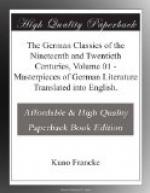The drama almost exclusively assumed a foreign, though kindred, form as a garb for the more elevated styles of composition: namely, the blank verse of the English stage, which Lessing’s Nathan the Wise had popularized and A.W. Schlegel’s Shakespeare had rendered omnipotent, and which Schiller forced upon his successors. The Romanticists, by playing unsuccessfully with different forms, as in Ludwig Tieck’s Octavianus, or Immerman’s Alexis, or by adopting pure antique or Spanish metres, attempted in vain to free themselves from the restraint of form, the great danger of which consisted in its similarity to common-place sentence construction, so that the verse ran the risk either of becoming prosaic, or else, in trying forcibly to avoid this, of growing bombastic. An escape was provided by inserting, in moments of emotion, a metre of a more lyrical quality into the uniform structure of the usual vehicle of dramatic dialogue, particularly when partaking of the nature of a monologue; as Goethe did, for example, in the “Song of the Fates” in Iphigenia, that most metrically perfect of all German dramatic poems, and as Schiller continued to do with increased boldness in the songs introduced into Mary Stuart. Perhaps the greatest perfection in such use of the principle of the “free rhythm” as applied to the drama, was reached by Franz Grillparzer in the Golden Fleece, on the model of certain fragments by Goethe, such as the Prometheus. On the other hand, the interesting experiments in the Bride of Messina are of more importance for the development of the opera into a work of art complete in itself, than for that of the drama. In general, however, it is to be remarked as a peculiarity of modern German drama, that it seeks to escape from monotony, which the French classical theatre hardly ever succeeded in avoiding, by calling in the aid of the other arts.




